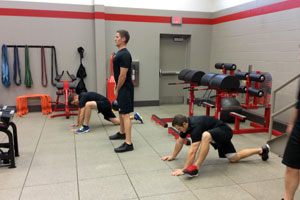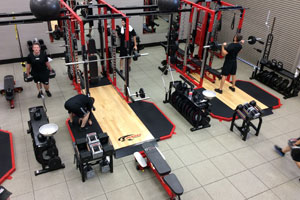Life in the Pits
Success by Fractions of a Second
 |
|
The Team Penske crew works out four days per week at the race shop. |
What started as a way to find new personnel for the over-the-wall crew when Penske Racing relocated its IndyCar team from Reading, PA to Mooresville, NC, this newly developed training program has turned into something the Team has committed to throughout the entire year.
Since stock car teams often employ pit stop specialists on race day, (many of whom are former college athletes) the IndyCar Team looked to the NASCAR side of Penske Racing to create a criteria for pit crew selection and evaluations. Rick Rinaman and Matt Jonsson chief mechanics for the #3 and #6 cars respectively met with Bob Pressley, strength trainer at Penske Racing and Trent Cherry, Pit Coach and rear tire carrier for the #12 Alltel Dodge, to begin developing the program.
In addition to preparing the cars in the race shop before each race weekend, the Indy Car crew also participates in daily workouts. During the off-season, the Team trains four times per week at 7 a.m. and alternates between various cardiovascular workouts and strength training. In addition to improving their performance in the pits, these workouts are designed to make the crew more resilient so that they're just as fit and injury free at the last race of the year as they are at the first.
 |
To re-create a live-action pit stop, Penske Racing has built a replica pit wall with three pit stalls (one for the IndyCar Team, one for the NASCAR Teams and one for the ALMS Teams) that the Team uses to train by employing different scenarios that can occur in the pits, as well as drills for individual positions. Furthermore, each stop is video taped and timed, so that they can be analyzed to identify potential areas of improvement.
"While it might seem that this program wouldn't be well regarded by the crew, we haven't received a single complaint. In fact, we've had some guys who have lost 15-20 pounds and wish we had been doing these workouts all along," said Jonsson. "The guys realize that the level of competition in the IndyCar Series is very high and fractions of a second, can mean the difference between winning and losing a race. Especially on some of the circuits where on-track passing can be difficult, gaining positions in the pits is critically important."
So has the pit crew training program paid off?
The ultimate measure came at the Indianapolis Motor Speedway this season during the annual Pit Stop Competition. The crew of the No. 3 Shell-Pennzoil Ultra Chevrolet navigated their way through the tournament-style competition to win the title.
Since the inception of the competition in 1977, Penske Racing has been crowned Champion a record 14 times including seven of the last nine seasons.